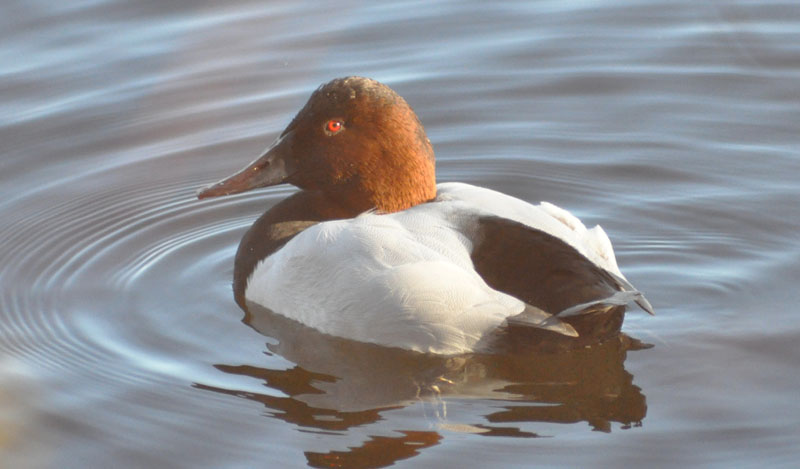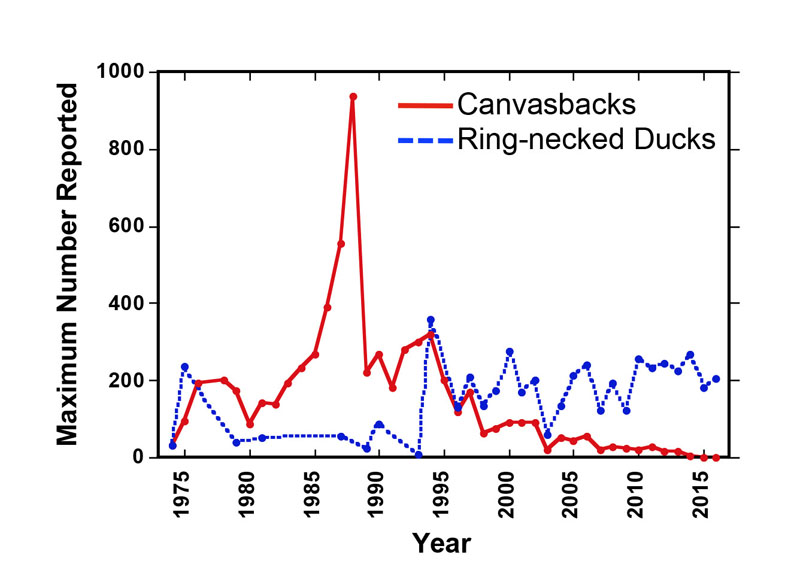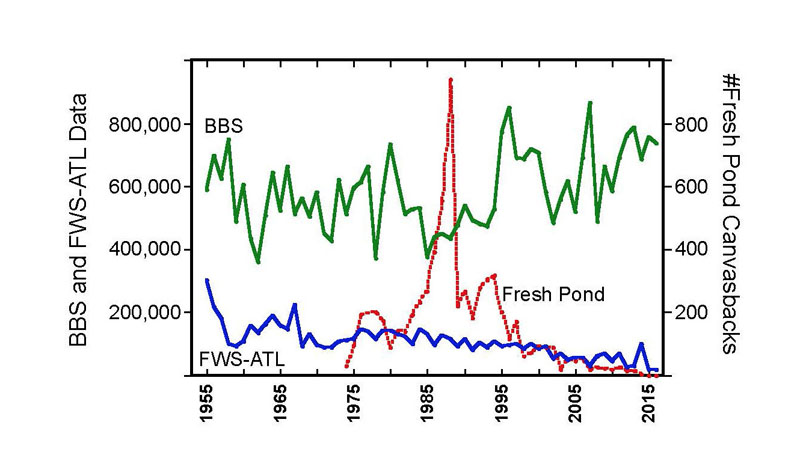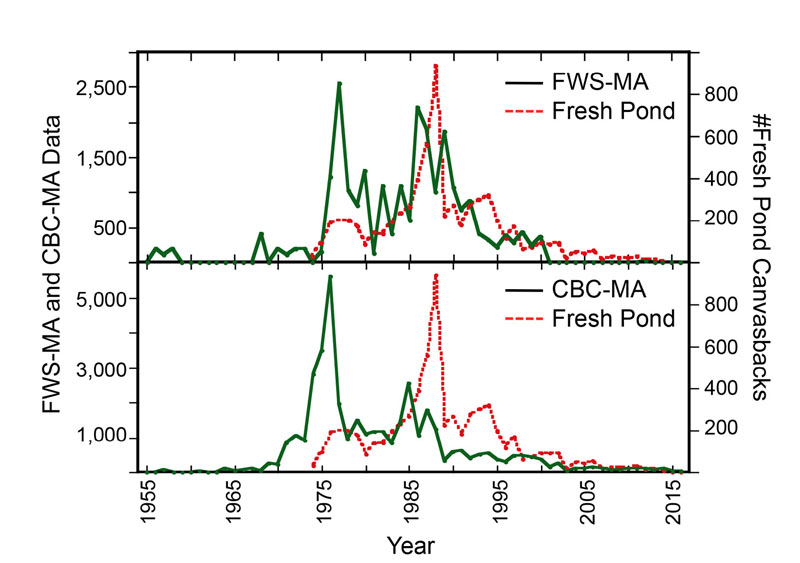Jeffrey Boone Miller

Drake Canvasback at Fresh Pond on November 8, 2011. Photograph by the author.
Fresh Pond in Cambridge, Massachusetts, has for decades been a reliable location for urban birders to see many species of waterfowl during the autumn migration (Robinson 1975, Barton 1995). Notably, Fresh Pond has been perhaps the best place in all of New England to see Canvasback ducks (Aythya valisineria), particularly at close range (see photo). When we first arrived in Massachusetts from San Francisco in October 1988, one of the first places my wife Kathleen Buckley took me was Fresh Pond. On this first walk around the pond, we saw dozens and dozens of Canvasbacks, a bird I have loved to see since I first encountered them on the lakes near my hometown of Spokane, Washington.
Since that first trip in 1988, I have returned every autumn to Fresh Pond, always coming on multiple days to observe the migration. During these almost thirty years, I, along with many other observers, have noted that the number of Canvasbacks has gradually dropped so that in the past three seasons only a handful has been seen. For example, as noted by Rines (2017) regarding November and December 2016:
There was a time when Fresh Pond in Cambridge was one of the best places in the state to find Canvasbacks, with counts over 100 in the 1990s. Numbers have dwindled since then, with only one seen during this reporting period.
This essay describes my attempt to understand why Canvasback numbers have decreased so markedly at Fresh Pond over the last two decades.

Figure 1. Maximum numbers of Canvasbacks (solid line) and Ring-Necked Ducks (dotted line) reported at Fresh Pond for 1974–2016. Data from Bird Observer, Barton (1995), and eBird.
Forty-plus years of Canvasback records at Fresh Pond
Bird Observer began publication in 1973 and since then has continuously published records of bird sightings in Massachusetts. In almost every year, the compilers of these records—for whom I have unbounded admiration—have included the number of Canvasbacks at Fresh Pond. In addition, Barton (1995) compiled eleven years of Fresh Pond records and, more recently, many observers including me have contributed their observations of Canvasbacks at Fresh Pond to the eBird website. Most records from Bird Observer have also been added to eBird. I used these sources to identify and graph the maximum number of Canvasbacks observed at Fresh Pond during each autumn migration period (October–January) for the years 1974–2016 (Figure 1). For comparison, I also graphed the number of Ring-necked Ducks.
These data show that Canvasback numbers peaked at Fresh Pond in 1988—the very year I first visited—at around 1000. The records also confirmed that Canvasback numbers started decreasing in the mid-1990s. The last time more than 100 birds were seen was in 1997 with 170. The last year with more than 50 was 2006 with 54, the last year with more than 10 was 2013 with 16, and 2014–2016 had four or fewer each year. Though only one bird was reported in 2016, I saw both a female and a male Canvasback on separate visits, so there were at least two different birds. In contrast, Ring-necked Duck numbers have remained stable at approximately 200–300 throughout the period when the Canvasback numbers have been declining. Ruddy Ducks, though more variable than Ring-necks in number—and not shown on the graph—have also maintained their numbers at typically 25–100 throughout this period. Whatever is leading to the decline of Canvasbacks at Fresh Pond is clearly not affecting the Ring-necks and Ruddys.
Looking at Figure 1, it appears that Canvasback numbers were increasing throughout the mid-70s. For years prior to 1974, however, I have so far not been able to find records of Canvasback numbers at Fresh Pond. Thus, I don’t know if this rise in numbers began from a pre-1974 period of very few birds (i.e., similar to 2014–2016), or if numbers had been higher in those earlier years. The data in Figure 1 thus raise, but can’t answer, the question of whether it is the low number of Canvasbacks in 2014–2016, rather than the high numbers in 1980s and 1990s, that should be considered the usual state of affairs. To try to answer this question, I turned to earlier historical sources and alternative data sources.
Historical notes about Canvasbacks at Fresh Pond and in Massachusetts
In addition to providing a respite for urban dwellers, Fresh Pond has attracted the sustained attention of botanists (Bigelow 1824), philosophers (Emerson 1910) and, of course, ornithologists (Brewster 1906, Forbush 1912) since the early days of the Commonwealth. Canvasbacks have always been a duck of great interest, for reasons both aesthetic and—during the market gunning era—economic. Canvasbacks that fed on wild celery were good to eat and could sell for two or three dollars (Forbush 1912). So, what do these early sources suggest about the likely numbers of Canvasbacks at Fresh Pond?
In his memoir of Cambridge birding, Brewster (1906) includes information about the waterfowl at Fresh Pond both in 1867–1871, an era when hunting was allowed, and during the first years of the 1900s, well after Cambridge banned shooting at the pond in 1884. His descriptions of the pond, the neighboring Great Swamp of Cambridge, the local birds, and his companions are well worth reading, but, for this essay, it is his observations of Canvasbacks that are of interest. Brewster listed the Canvasback as “of very rare occurrence during migration” and was able to provide only three records. One record was from an 1846 meeting of the Boston Society of Natural History at which Dr. S. Cabot Jr. noted that a Canvasback had been taken by Captain N. J. Wyeth at Fresh Pond (Gould 1848). Though the date this bird was taken was not given, the Wyeth family had been at Fresh Pond since 1797 (Sinclair 2009). The other two records of Canvasbacks at Fresh Pond provided by Brewster included one bird seen in autumn of 1903 and another single bird seen in December of 1905. Brewster was a comprehensive observer of Cambridge birdlife, so his observations suggest that Canvasbacks were almost vanishingly rare at Fresh Pond throughout the 1800s and into the early 1900s.
The accounts of Job (1897), Fay (1910), and Phillips (1925) show that observations in Massachusetts of even small numbers of Canvasbacks were considered noteworthy, again suggesting that this species was historically rare in our area. Similarly, Forbush (1912) states, “In my early years, the Canvas-back was regarded as little more than a straggler in New England, though occasionally a few were taken.”

Figure 2. Estimated Canvasback populations for the North American continent from Breeding Bird Survey data (BBS, upper solid line) and for wintering Canvasbacks in the Atlantic Flyway from U.S. Fish and Wildlife Service midwinter waterfowl surveys (FWS-ATL, lower solid line). Shown for comparison are the numbers for Fresh Pond from Figure 2 (dotted line, but note different scale on right axis).
Though agreeing that the Canvasback was generally rare, these writers also noted that, in some years (e.g., 1896 and 1901–1905), Canvasbacks arrived in noticeably larger numbers than in other years. However, even in what Job (1897) called the “phenomenal flight” of 1896, his note included observations of only eight Canvasbacks.
More Numbers—it’s a New England Phenomenon
Taken together, the historical accounts and the data from the past forty years suggest that Canvasbacks have usually been rare at Fresh Pond. Thus, the high numbers in the late 1980s and early 1990s may have been an anomaly, and the recent low numbers may represent a return to the more common state. To further investigate possible reasons for this very local population change, I turned to more comprehensive surveys of Canvasbacks.
First, I considered whether local Canvasback numbers might be a simple reflection of the total Canvasback population. As shown in Figure 2, however, the total North American population of Canvasbacks, as estimated from the Breeding Bird Survey (BBS), has been on a slow upward trend, and its fluctuations do not mirror the changes at Fresh Pond. Thus, the decreasing numbers of Canvasbacks at Fresh Pond are not due to a decreased total population of Canvasbacks. Barton (1995) similarly concluded that Canvasback numbers at Fresh Pond were not coupled to continental populations.

Figure 3. Estimated wintering Canvasback populations in Massachusetts from the USFWS midwinter waterfowl survey (FWS-MA, top panel, solid line) and from all Massachusetts Christmas Bird Counts combined (CBC-MA, lower panel, solid line). Shown for comparison are the numbers for Fresh Pond from Figure 2 (dotted line in each panel, but note different scale on right axis).
Next, I considered how Canvasback populations in our Atlantic Flyway, as estimated from the U.S. Fish and Wildlife Service (USFWS) midwinter waterfowl surveys, might correlate with the numbers at Fresh Pond. The data from these surveys, which can be accessed online, have documented a consistent decrease in wintering populations of Canvasbacks in the Atlantic Flyway during the past 60 years (Figure 2). Indeed, as habitat quality has declined in Chesapeake Bay, which was once home to hundreds of thousands of wintering Canvasbacks, their wintering range has been shifting westward into the Central Flyway (Mowbray 2002). Over the past 20 years, the decrease in Atlantic Flyway Canvasbacks has coincided with the decreasing numbers at Fresh Pond. This result is unsurprising, because the birds at Fresh Pond must be drawn from the pool of Atlantic Flyway birds. However, the overall Atlantic Flyway numbers did not show a peak in the 1985–1995 period to correspond with the peak numbers at Fresh Pond. Thus, perhaps unsurprisingly, there seems to be no simple one-to-one correlation between the number of Canvasbacks wintering in the Atlantic Flyway and the number that appear at Fresh Pond. This result suggests that factors at less than flyway scale are important in determining Canvasback numbers at the pond.
To examine more local changes, I next examined Massachusetts county-specific records in eBird and found that only on Nantucket have Canvasbacks continued to be consistently reported. For example, each year from 2009–2017, eBird reports from Nantucket have included high counts of 37 or more (range = 37–230) Canvasbacks on the island’s ponds, with peak numbers often in February or March. In contrast, only scattered reports of small numbers of birds were reported during this period from Barnstable County on Cape Cod or from Bristol and Norfolk counties in southeastern Massachusetts. Remarkably, no Canvasbacks have been reported since 2009 from Dukes County, which includes Martha’s Vineyard. Though the data in eBird showed that Canvasbacks continue to be found on Nantucket, I found that there were some years and counties for which eBird lacked data, thus limiting its usefulness.
Finally, to find more complete data for our region, I examined Canvasback records from the Audubon Society Christmas Bird Counts (CBC) for Massachusetts and Rhode Island, as well as records from the Massachusetts state-specific USFWS midwinter surveys, all of which are available online. These records show that over the past two decades, wintering Canvasbacks have almost disappeared not only from Fresh Pond, but from all of Massachusetts (Figure 3) and Rhode Island (not shown). In addition, these two data sets agree that Canvasbacks were rare in Massachusetts throughout the 1950s and 1960s, more abundant from the mid-1970s to the mid-1990s, and decreasing from the mid-1990s through 2016. This pattern roughly coincides with the trends at Fresh Pond. For the CBCs, birds on Nantucket composed 70–97% of the Canvasbacks reported in the 2009–2016 period, which is consistent with the eBird data. In contrast, Nantucket birds typically represented <10% of the Canvasbacks in Massachusetts during the 1980s and early 1990s, when Canvasbacks were both more numerous and more widely distributed in Massachusetts. Rather than being a strictly local phenomenon at Fresh Pond, therefore, the decreasing numbers of Canvasbacks over the past two decades appear to have occurred throughout much of southeastern New England, with the notable exception of Nantucket.
What about Food?
When I first contemplated this essay, my hypothesis was that Canvasbacks might be decreasing at Fresh Pond due to habitat change, including perhaps a decrease in their preferred foods. As is well known, Canvasbacks have a particular fondness for wild celery (Vallisneria americana)—also known as American eelgrass or tape-grass—especially during the nonbreeding seasons. Historically, wild celery has been found at Fresh Pond. Bigelow (1824) notes that he collected wild celery at Fresh Pond, and in the digital collections of the Harvard University Herbaria I found images of wild celery plants collected at Fresh Pond in 1910 and 1917 (Harvard University Herbaria 2017). Furthermore, writing in 2002, Mowbray noted, “During past 40 yr, Canvasbacks have altered traditional migration routes, changed wintering sites, and modified diets in response to changes in availability and predictability of certain foods.”
So, it seemed plausible that changes in Canvasback numbers at Fresh Pond were following changes in food availability.
Unfortunately, I was not able to determine the current status of wild celery or other potential Canvasback foods at Fresh Pond. I corresponded with Jean Rogers, the chief ranger at the Fresh Pond Reservation, and she wrote that no studies had been made of the aquatic vegetation at Fresh Pond. I have also been unable to find observations that identify what Canvasbacks eat at Fresh Pond—I am embarrassed to say that I never noticed!
Though some key information is missing, I am nonetheless willing to risk concluding that change in food availability is unlikely to have driven the large changes, both up and down, in Canvasback numbers at Fresh Pond. My reason is that, as noted above, Canvasback numbers have changed more or less synchronously throughout all of southeastern New England. It’s hard to believe that region-wide changes in availability of foods such as wild celery would have gone unnoticed. Furthermore, if such food changes had occurred only at Fresh Pond, then I would have expected changes in Canvasback numbers to have been similarly limited to Fresh Pond, rather than changing over the entire region as was the case. Finally, Canvasbacks are able to eat many kinds of foods, including invertebrates such as freshwater clams (Mowbray 2002), and I have noticed Ring-necked Ducks eating shellfish at Fresh Pond.
Changing Migration Patterns?
Could changes in migration patterns have led to the changing numbers of Canvasbacks at Fresh Pond and throughout Massachusetts? The general outlines of Canvasback breeding areas and migration routes have been understood for more than 100 years (Forbush 1912), and studies of banded and dye-marked Canvasbacks have provided additional details (Stewart, Geis, and Evans 1958; Serie, Trauger, and Sharp 1983).
Because Canvasbacks do not breed in the Atlantic Flyway, all of the birds that appear in New England originate from breeding areas and migrate via staging areas that are far to the west of us. One study found that autumn migrants destined for New England first congregate at staging areas on the Upper Mississippi River, for example, at the locations known as pools 7 and 8 on the border between southeastern Minnesota and western Wisconsin (Serie, Trauger, and Sharp 1983). From there, the birds head almost due east, likely passing Lake Erie and the Finger Lakes region of New York before entering New England.
For New England, the key fact about this migration is that a large majority of the Canvasbacks that winter in the Atlantic Flyway do not pass through New England at any time. Rather, they follow more southerly routes to the wintering grounds along the mid-Atlantic coast and on the Chesapeake Bay. As noted by Forbush (1912), “Only the most northerly edge of the great fan-shaped migrating movement reaches New England.”
Thus, if we are to see any Canvasbacks at Fresh Pond or other areas of Massachusetts, it’s necessary for the northern edge of the migration to pass into our region. Small displacements of the migration edge to the north or south—on the order of a hundred miles or so—could conceivably cause large changes in Canvasback numbers in New England.
Unfortunately, we lack the data needed to determine if Canvasback migration routes to New England have fluctuated over the past decades, so many questions remain unanswered. Is it possible that a northward shift in the migration route, which was then maintained for a couple of decades, was responsible for the increased number of Canvasbacks seen here from the mid-1970s until the mid-1990s? In years such as 2014–2016 when few Canvasbacks arrived in New England, did the Canvasbacks enter but then overfly New England or did the birds simply bypass New England on a more southerly route? Or did the birds stop before reaching New England, perhaps at Lake Erie or the Finger Lakes of New York? Where do the birds on Nantucket come from? If the migration route shifts northward in the future, will high numbers of Canvasbacks again return to Fresh Pond and southeastern New England? What factors determine where the northern edge of the migration route occurs? Do the birds in New England all originate from a single small breeding area? Has the migration route been affected by a shift to the northwest of breeding sites (Mowbray 2002) or by local changes in breeding success and populations? Have migration staging areas changed? What is the effect of ongoing climate change? To answer such questions, it would seem necessary to track birds with radio transmitters or other real-time tracking devices. Though there has been one study of radio-tracked female Canvasbacks wintering on the Chesapeake (Haramis, Jorde, and Bunck 1993), there have been, to my knowledge, no such studies of Canvasbacks in New England.
Conclusions
I began this essay with a simple question: why have Canvasback numbers decreased at Fresh Pond over the past two decades? Though I haven’t found a simple answer, my investigations did change my understanding of the problem.
First, I found that changes in Canvasback numbers at Fresh Pond are not a strictly local phenomenon, but rather mirror changes occurring throughout southeastern New England, with the exception of Nantucket. On the other hand, the Fresh Pond changes do not appear to be closely coupled to the overall Canvasback population in the Atlantic Flyway or to the total continental population. Thus, we should seek region-wide, in addition to local, understanding of Canvasback population changes.
Second, I found that the abundance of Canvasbacks at Fresh Pond in the late 1980s and early 1990s—when I first visited—was likely to have been historically unusual. Today’s low numbers may thus represent a return to a more common circumstance in which Canvasbacks are rare in our area.
Finally, it seems unlikely that decreased food availability led to the recent decrease in Canvasback numbers. On the other hand, northerly or southerly displacements in migration routes might well have contributed both to the abundance of Canvasbacks twenty years ago and to their rarity today. However, much more information is needed to reach definite conclusions about these possibilities.
Biology is a science in which history counts. Knowing that Canvasbacks are historically rare in our area and that there has not been a catastrophic local habitat change has given me a more optimistic view of the changes at Fresh Pond. In the coming autumn of 2017, it’s likely that only a handful Canvasbacks will appear. 2017 could even be the year when no Canvasbacks come to Fresh Pond. However, it’s also possible that this year—or some future year—will be the year when the trend changes and Canvasbacks start to become more abundant. I live in hope.
References
- Barton, J. H. 1995. Ten Years and a Year: The Fall Waterfowl Census at Fresh Pond, Cambridge, 1984-1993, 1994. Bird Observer 23 (1): 11–24.
- Bigelow, J. 1824. Florula Bostoniensis. A Collection of the Plants of Boston and its Vicinity with their Generic and Specific Characters, Principal Synonyms, Descriptions, Places of Growth, and Time of Flowering, and Occasional Remarks. Boston: Cummings, Hilliard, & Co.
- Brewster, W. 1906. The Birds of the Cambridge Region of Massachusetts. Cambridge: Nuttall Ornithological Club.
- Emerson, R. W. 1910. Journals of Ralph Waldo Emerson: with Annotations. April 11, 1834. Volume 3. Edited by Edward Waldo Emerson and Waldo Emerson Forbes. Boston and New York. Houghton Mifflin Company and Cambridge: The Riverside Press.
- Fay, S.P. 1910. The Canvas-back in Massachusetts. The Auk 27: 369–81.
- Forbush, E. H. 1912. A History of the Game Birds, Wild-Fowl, and Shore Birds of Massachusetts and Adjacent States. Boston: Wright & Potter.
- Gould A. A., 1848. Proceedings of the Boston Society of Natural History for January 7, 1846. Proceedings of the Boston Society of Natural History 2: 89. Boston: Freeman and Bolles.
- Harvard University Herbaria. 2017. Specimens of wild celery (Vallisneria americana) collected at Fresh Pond, Cambridge in 1910 and 1917 which are designated with barcodes 00635119 and 00635120 respectively. Accessed May 23, 2017.
- Haramis, G. M., D. G. Jorde, and C. M. Bunck. 1993. Survival of Hatching-Year Female Canvasbacks Wintering on Chesapeake Bay. The Journal of Wildlife Management 57: 763-71.
- Job, H. K. 1897. The Canvas-back Duck in Massachusetts. The Auk. 14: 206.
- Mowbray, T. 2002. Canvasback (Aythya valisineria) in The Birds of North America Online (P. G. Rodewald, Ed.). Ithaca: Cornell Lab of Ornithology.
- Phillips, John C. 1925. A Natural History of the Ducks. Canvas-back. Volume 3, pages 121-144. Boston and New York: Houghton Mifflin and Cambridge: The University Press.
- Robinson, L. 1975. Fresh Pond’s Autumn Waterfowl. Bird Observer 3 (4): 120–22.
- Rines, M. W. 2017. Bird Sightings, November–December 2016. Waterfowl through Alcids. Bird Observer 45: 133–34.
- Serie, J. R., D. L. Trauger, and D. E. Sharp. 1983. Migration and Winter Distributions of Canvasbacks Staging on the Upper Mississippi River. The Journal of Wildlife Management 47: 741-53.
- Sinclair, J. 2009. Fresh Pond. The History of a Cambridge Landscape. Cambridge: MIT Press.
- Stewart, R. E., A. D. Geis, and C. D. Evans. 1958. Distribution of Populations and Hunting Kill of the Canvasback. The Journal of Wildlife Management 22: 333-70.
Jeffrey Boone Miller is a Professor of Neurology and Physiology at the Boston University School of Medicine, a member of the Board of Tutors in Biochemical Sciences at Harvard University, and an Associate Editor of Bird Observer. Jeff is an advocate for birding locally and habitat preservation. Primary data used for this article are available by contacting him at jboonemiller@icloud.com. He thanks Jean Rogers, Jim Barton, Wayne Petersen, and Michael R. Miller for helpful information and Kathleen Buckley for first taking him to Fresh Pond.